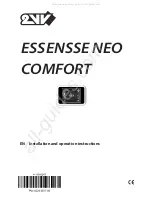
Types 1098-EGR and 1098H-EGR
9
CAuTION
Introduce pilot supply pressure into
the regulator before introducing any
downstream pressure or internal damage
may occur due to reverse pressurization
of the pilot and main valve components.
Always use pressure gauges to monitor downstream
pressure during startup. Procedures used in putting
this regulator into operation must be planned
accordingly if the downstream system is pressurized
by another regulator or by a manual bypass.
Note
For proper operation, pilot supply
pressure must exceed control pressure
by the minimum amount specified on
the actuator nameplate as minimum
differential pressure.
The only adjustment necessary on a Type 1098-EGR
or 1098H-EGR regulator is the pressure setting of
the pilot control spring. Turning the adjusting screw
clockwise into the spring case increases the spring
compression and pressure setting. Turning the
adjusting screw counterclockwise decreases the spring
compression and pressure setting.
Pilot Adjustment
To adjust standard 6350 Series pilots:
Loosen the
locknut and turn the adjusting screw. Then tighten
the locknut to maintain the adjustment position.
On a standard Types 6352 through 6354M pilots,
closing cap must be removed before adjustment and
replaced afterward.
!
wARNINg
To avoid possible personal injury from
a pressure-loaded pilot, carefully vent
the spring case before removing the
closing cap. Otherwise, trapped loading
pressure could forcefully eject the freed
closing cap.
To adjust the 61 Series or Type y600AM pilots:
Remove the closing cap and turn the adjusting screw.
Any adjustments made should set the controlled
pressure within the appropriate spring range shown
in the Table 2.
Startup
1. Slowly open the pilot supply line hand valve.
2. Slowly open the upstream block valve and partially
open the downstream block valve for minimum
flow. Slowly open the hand valve in the
control line.
3.
Adjust the pilot setting, if necessary.
4. Completely open the downstream block valve.
5.
Slowly close the bypass valve, if any.
Dual-Pilot Boiler Fuel Control
Applications
To enhance proper operation and adequate response
to negative pressure shock condition in low differential
pressure boiler fuel control applications, use the
Type 1098-EGR boiler fuel configuration:
•
Type 1098-EGR with Type 6352 pilot
•
Size 70 Actuator
•
Quick Opening Cage
•
Yellow Main Spring
•
Type Y600AM or 627M Auxiliary Pilot mounted in
parallel with the Type 6352 pilot
To provide faster response, two pilots mounted
in parallel sense the downstream pressure. The
Type 6352 pilot is the primary controlling pilot and
the Type Y600AM or 627M auxiliary pilot stands by
until it senses a negative pressure shock condition.
The auxiliary pilot opens, allowing additional flow
into the actuator, increasing the stroking speed and
providing faster response. See Figure 4 for schematic.
The quick-opening cage allows maximum capacity at
shorter travels to decrease stroking time in opening
and closing directions. The service conditions should
not exceed 20 psig / 1.4 bar maximum inlet pressure
and 10 psi / 0.69 bar maximum differential pressure.
If a pilot light is present, supply it gas with the
Type 1098- EGR. The pilot light gas supply line should
branch off the main fuel line downstream of the
Type 1098-EGR and include a separate regulator to
control the final pilot light gas pressure, if required (see
Figure 5). This allows the Type 1098-EGR to have its
main valve plug just off the seat waiting for the sudden
negative shock created when the boiler solenoid
valve is opened to light the boiler to the high fire load.
This installation practice significantly increases the
stroking speed of the Type 1098-EGR. See Figure 5
for schematic.










































